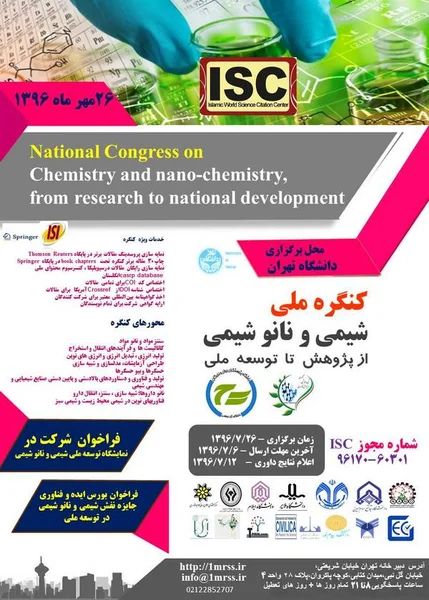-
preparation ,characterization and applications of nanoparticles using nanotechnology toward advancing personalized nanomedicine
جزئیات بیشتر مقاله- تاریخ ارائه: 1396/07/16
- تاریخ انتشار در تی پی بین: 1396/07/16
- تعداد بازدید: 422
- تعداد پرسش و پاسخ ها: 0
- شماره تماس دبیرخانه رویداد: -
nanotechnology offers many potential benefits to medical research by making pharmaceuticals more efficacious and by decreasing their adverse side-effects. preclinical characterization of nanoparticles intended for medical applications is complicated – due to the variety of materials used, their unique surface properties and multifunctional nature. prior to an involved discussion of protocols for nanotechnology, a definition of terms is in order. the si prefix “nano” means a billionth (10-9) part, and a nanometer is thus a billionth of a meter (about one hundred thousandth the thickness of a sheet of paper). an object is nanoscale, then, when it is of a size convenient to measure in nanometers – generally less in size than a micron. the nanoscale is also the size scale at which the properties of a material are often different than they are for the bulk (or “macroscale”) phase. for many materials, this is approximately in the 1–300 nm size range. in this size range, properties change because as things become very small, their surfaces shrink more slowly than their volumes, causing nanoscale materials (“nanomaterials”) to have far larger surface-to-volume ratios than larger objects. more surface area can mean that nanomaterials have higher reactivity; different elastic, tensile, and magnetic properties; increased conductivity; or increased tendency to reflect and refract light. the food and drug administration (fda) and pharmaceutical industry have used standards to assess material biocompatibility, immunotoxicity, purity, and sterility (as well as many other properties) for several decades. nanotechnology offers the potential to significantly transform diagnostics and therapeutics. the ability to manipulate the biological and physicochemical properties at the macromolecular size-scale allows for efficient drug targeting and delivery, which result in greater potency and decreased adverse side effects. nanoparticles intended for clinical applications consist of a wide variety of materials, for which preclinical characterization is particularly challenging. most nanoparticle formulations include surfactants to promote dispersion (i.e., prevent agglomeration) of the primary particles. these compounds too can interfere with conventional characterization methods. impurities and contaminants which adsorb to nanoparticle surfaces can also contribute to ambiguous analytical results. these difficulties tend to hamper the development of standards for characterization and the subsequent clinical application of nanoparticles. a rational characterization strategy for biomedical nanoparticles contains three elements: physicochemical characterization, in vitro assays, and in vivo studies. each of these is essential to a comprehensive understanding of nanoparticle safety and efficacy. in spite of these difficulties development of nanoparticles for drug delivery has progressed by leaps and bounds over the last few decades, facilitating the possibility of an efficacious therapy for some fatal diseases. this development has stemmed from either the unsuitable physicochemical characteristics of the existing drug molecules, such as limited solubility and hence poor bioavailability, or the inadequacy of the conventional delivery systems to provide safe and efficient delivery. so nanoscale materials (nsms) are gaining attention due to their small size and unique physiochemical properties.
حوزه های تحت پوشش رویداد
مقالات جدیدترین رویدادها
-
استفاده از تحلیل اهمیت-عملکرد در ارائه الگوی مدیریت خلاقیت سازمانی و ارائه راهکار جهت بهبود
-
بررسی تاثیر ارزش وجوه نقد مازاد بر ساختار سرمایه شرکت های پذیرفته شده در بورس اوراق بهادار تهران
-
بررسی تأثیر سطح افشای ریسک بر قرارداد بدهی شرکت های پذیرفته شده در بورس اوراق بهادار تهران
-
بررسی تأثیر رتبه بندی اعتباری مبتنی بر مدل امتیاز بازار نوظهور بر نقد شوندگی سهام با تأکید بر خصوصی سازی شرکت ها
-
تأثیر آمیخته بازاریابی پوشاک ایرانی بر تصویر ذهنی مشتری پوشاک ایرانی (هاکوپیان)
-
بررسی پارامترهای موثر بر مقاومت برشی و مکانیسم خرابی ستون های کوتاه بتن آرمه مستطیلی با استفاده از مدل المان محدود غیر خطی
-
بررسی میزان تأثیر پارامترهای لرزهای در رفتار دینامیکی دیوارهای خاکی میخکوبی شده
-
ارزیابی مقاومت فشاری بتن خودتراکم حاوی مواد پودری مختلف از طریق روش امواج اولتراسونیک
-
نقش اماکن گردشگری در توسعه کارآفرینی شهرها مخصوصا شهرستان ارومیه
-
activation of prosurvival signaling pathways during the memory phase of volatile anesthetic preconditioning in human myocardium: a pilot study
مقالات جدیدترین ژورنال ها
-
مدیریت و بررسی افسردگی دانش آموزان دختر مقطع متوسطه دوم در دروان کرونا در شهرستان دزفول
-
مدیریت و بررسی خرد سیاسی در اندیشه ی فردوسی در ادب ایران
-
واکاوی و مدیریت توصیفی قلمدان(جاکلیدی)ضریح در موزه آستان قدس رضوی
-
بررسی تاثیر خلاقیت، دانش و انگیزه کارکنان بر پیشنهادات نوآورانه کارکنان ( مورد مطالعه: هتل های 3 و 4 ستاره استان کرمان)
-
بررسی تاثیر کیفیت سیستم های اطلاعاتی بر تصمیم گیری موفق در شرکتهای تولیدی استان اصفهان (مورد مطالعه: مدیران شرکتهای تولیدی استان اصفهان)
-
بازشناسی تطبیقی ادبیات غنایی بر قالی سنگشکو با تاکید بر نگاره های مصور خمسه نظامی در دورۀ صفوی (مطالعه موردی: دیدار لیلی و مجنون و آبتنی شیرین)
-
بررسی تاثیر عوامل روانشناختی بر قصد خرید و تعهد مشتری (مطالعه موردی: مشتریان پوشاک هاکوپیان مشهد)
-
isolation, purification and identification of β-carotene from azolla pinnata r. br. as a new carotenoid wealthy source
-
seismic loss assessment: the case study of the power distribution network in arak city, iran
-
evaluation of aesthetic, functional, and environmental effects on the design of urban open spaces: a case study of istanbul şişhane park, turkey




سوال خود را در مورد این مقاله مطرح نمایید :